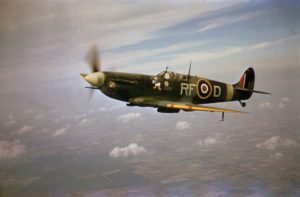Though the Second World War was never fought on British land, only in the skies overhead, the country’s fabric is marked by the conflict in innumerable ways. Near my home is a stretch of woodland I often run through with the dog. In 1945, an Allied plane crashed among its trees, killing several of the men on board. To this day, local legend has it that visitors to the crash site will hear voices or coughing, or smell smoke.
But for how much longer will we remember those ghosts? This week marks the 80th anniversary of VE Day — the moment the war ended in Europe. The youngest surviving veterans are now at least 98. And of the millions of British people who served in the war, only tens of thousands remain: perhaps 0.01% of Britain’s total population.
But perhaps the question should rather be: what will we remember? In theory, an event doesn’t need to be within living memory to be memorialised. In practice, though, as the generations change, the meaning of even the most notable historic moments will waver and mutate. We still mark the foiled attempt by Guy Fawkes to blow up the Houses of Parliament, for example, but few remember the details of what Fawkes was trying to achieve.
Similarly, when I was a child, there were still First World War veterans alive: I remember interviewing Bill, a local veteran of both wars, for a school homework assignment. He had lied about his age to volunteer in 1914 when just 14, and was in his nineties when I spoke to him. He would spend all day sitting on a pavement bench, in full uniform including medals, nodding and smiling at passers-by. He talked vividly about his war memories for my project, but seemed largely oblivious to the modern world. That long-ago war was, for him, still all of meaning and reality, along with most of his personality.
What did that war mean, though? My school history lessons presented its origins as murky, and largely driven by longstanding European rivalries. More recently, though, now that the last of its veterans has died, I’ve noticed this war increasingly repurposed as a Goodies Versus Baddies fable about “freedom and democracy”. And so it may soon be with the Second World War, however many of its ghosts still haunt Britain’s woodlands.
This week, ceremonial officialdom creaked into gear for the four-day celebration of “VE 80”, complete with military parades, fly-bys and appearances by the Royal Family. But as I watched BBC coverage of dress-uniformed soldiers marching down the Mall past the King, two things struck me. Firstly: each group was neatly formed, beautifully trained — and teeny weeny, mere pocket-sized mini-units dwarfed by the scale of a thoroughfare designed for huge parading battalions. It felt like a vivid metaphor for a Britain that rattles around in architecture built for an entirely grander state. And second: that as living memory of the Second World War fades, much more is about to pass from us than the last of the Greatest Generation.
Who were they, that generation? And how do we remember them? Two days before the military mini-units marched down Pall Mall, the ghostly airmen of my local woodland seemed briefly as though they might see another modern-day echo, when a Spitfire crash-landed in a field in Kent. All on board were, mercifully, safe — but it felt like an omen. For there is something especially emblematic about these twin-engined fighter planes.
The excitement and admiration that has always clung to folk memory of Britain’s role in the Second World War also flew on twin engines: technical inventiveness, and manic bravery. While my step-grandfather was a POW in Colditz, for example, he hand-built a glider with which he planned to escape over the battlements — a staggeringly risky engineering project only interrupted by rescue when the war ended.
Perhaps more than any other symbol of the Second World War, the Spitfire stands as an emblem for this mix of can-do engineering and wild risk-taking that enabled Allied airmen, some still teenagers, to take to the skies in the legendary 1940 “Battle of Britain”. But though we won the Battle of Britain, and eventually VE Day too, all of Europe lost the war. It was civilisation-destroying. With it ended industrial, imperial Europe, and in its aftermath arose a new civilisation centred on America: one only superficially in continuity with what it succeeded, and whose explicit foreign policy it has been ever since to ensure the Old World never regained its pre-1945 bellicosity.
This policy was, of course, not simply imposed on Europe. For the most part it happened with the active support of at least the leadership class, among European peoples shattered and traumatised by the bloodshed. But its effects have been far-reaching. Under the new order, nationalism was decried, and the universal fraternity of all peoples extolled. A new aspiration to global peace and cooperation based on institutions and rules took shape, even as national borders and peoples were encouraged to become ever more porous, fluid, and intermingled.
We have lived within the resulting consensus ever since. These days we often refer casually to “the West”, as a collective; implicitly we mean by this the alliance within which the post-war consensus holds, underwritten by American hard power. The centre of the world is now Washington. All that remains of imperial Europe is museums, architecture, and some carefully-preserved examples of the machines that enabled both that era’s manic bravery, and also the horrific war it produced. And those surviving machines which are not in museums or private collections have been repurposed for the central cultural activity of the successor civilisation, “the West”: individual consumer experience. An hour-long “Battle of Britain” flight with Fly a Spitfire, the company whose plane crash-landed over the weekend, costs £6,750.
1945 was thus a rupture in more ways than one. Fully 95% of Britain’s population today comprises those who grew up in “the West” that succeeded it. Like shepherds grazing their flocks among the ruins of the Colosseum, this much-reduced successor Britain trots its dinky military along vast avenues, or turns its palaces and vintage machines into tourist spectacle, or simply builds over the traces of a bygone culture and worldview largely opaque to us.
Now, as the remaining Second World War veterans approach their own centuries, and even the lovingly maintained museum-piece Spitfires are struggling, it won’t be long before even those who remember how it ended will be gone. What will VE Day mean then? I don’t think it’s a coincidence, in this context, that we are once again witnessing land war at the edges of Europe itself. Nor do I think it’s a coincidence that Second World War and even Holocaust revisionism is on the rise, in the bowels of the internet. Such revisionism often involves a worryingly sketchy or actively malign twisting of historical fact; and its bedrock enabler is less ignorance as such, which is surely a human constant, than the events themselves passing from living memory.
As this proceeds, long-settled narratives are showing signs of increasingly volatile contestation — and not just in the more lurid corners of the online Right. The meaning of the Second World War, and its memorials, is a target for progressives as well: a fact signalled by the orange crash barriers surrounding the flag-draped Cenotaph, in a photo posted on Monday by the Ministry of Defence. This casual mix of pre-war grandeur and ugly, plastic safetyism epitomises the dispiriting contrast between pre- and post-war British sensibilities. But it also points to the increasing politicisation of war memorials in general. The Cenotaph in particular has become a popular target for protest, and sometimes vandalism, by (usually) far-Left protesters with grievances from Gaza to climate change. So frequent and provocative a focus for publicity-seeking political actions have war memorials become that there have even been nativist counter-protests. In 2024, the Government criminalised climbing on such structures during political actions.
By the time the Bank Holiday Monday VE Day ceremonies reached the Cenotaph, the crash barriers had been removed and serene solemnity reigned. But there was a time when no barriers would have been necessary.
Some disgruntled Brits attribute this, and other purported signs of indifference to VE Day, to demographic change. Given that only 37% of London residents are white British, perhaps rather fewer of the city’s contemporary majority feel an emotional connection to sacrifices made almost a century ago, for a country to which their own ancestors sometimes had very different relationships. As a byproduct of the utopian softening of borders, this demographic change is, itself, an effect of the post-war internationalism that characterised “the West” as it has existed since 1945. And, as underlined by recent Gaza protests, the cultural pluralism that results is undoubtedly accelerating the loss of shared reverence for British war memorials.
But the fading of VE Day is not, or not only, a matter of multiculturalism. Were this the case, we might expect celebrations to be as enthusiastic as ever, in those parts of Britain where most inhabitants have ancestors who served. My Shires town is one such area. And yet there were, to my knowledge, no local events to coincide with the grand parades in London. To the extent that it accelerates the loss of shared reverence for the lessons of the Second World War, then, the post-war internationalism embraced by “the West” is indisputably hard at work dissolving its own legitimising consensus. But demographic change is more an effect of this dissolution than its principal cause. This is, in the last count, simply a matter of time.
The Second World War itself was a cataclysm so immense that it obliterated almost everything Britain had previously been. Poor shattered Bill dressed in full military uniform every day into his nineties; and it’s as though Britain somehow did the same, at the scale of a whole country. So as we salute the last of the Greatest Generation, perhaps we can also feel a sense of relief at the prospect of letting those memories fade a little, in time. We should not forget the effort, the sacrifices, or the courage. But letting that era pass beyond living memory may also, in time, grant us more room to take stock of the kind of place Britain is now.
What will we conclude? It need not be defeatist. I dare say some of those ghostly airmen long to rest; if we could only grant this, perhaps those of us alive now might feel more able to do away with the figurative crash barriers and take up their legacy of inventiveness and daring. Then, perhaps, in holding our past just a little more lightly, Britain might one day be free to have a future again.
a.appcomments {
background: #FFF;
border: 1px solid #446c76 !important;
font-family: benton-sans,sans-serif;
font-weight: 600;
font-style: normal;
font-size: 12px;
color: #446c76 !important;
padding: 12px 50px;
text-transform: uppercase;
letter-spacing: 1.5px;
text-decoration: none;
width: 100%;
display: block;
text-align: center !important;
}



















